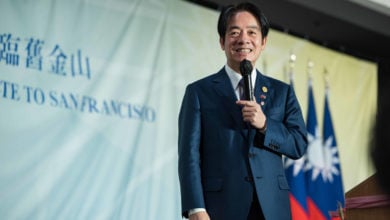The first major summit between top U.S. and Chinese officials ended on March 19 in Anchorage, Alaska, and reflected the profound tensions that have come to define the relationship between the two countries. The U.S. side, represented by Secretary of State Antony Blinken and National Security Adviser Jake Sullivan, used the meeting as an opportunity to press on key pressure points, in line with the “great power competition” doctrine of fomenting a new Cold War-style period of confrontation. At the conclusion of the summit, Blinken remarked that the two sides were “fundamentally at odds” on key economic and political issues that China considers to be fundamental to their internal stability and sovereign rights in the world.
Yang Jiechi and Wang Yi, the two top diplomats in the Chinese government, were in no mood to be pushed around. Yang expressed his “staunch opposition” to “U.S. interference in China’s internal affairs,” warning that China would “take firm actions in response.” Yang also denounced the U.S. practice of using, “military force and financial hegemony to carry out long- arm jurisdiction and suppress other countries.” The Chinese delegation raised the issue of human rights abuses carried out by the U.S. government targeting Black Americans.
Clearly no progress was made towards the easing of diplomatic tensions — and the Biden administration showed little interest toward that end. Just two days before the opening of the Alaska summit, Washington announced it was imposing sanctions on 24 Chinese officials over the central government’s policies in the city of Hong Kong. Biden and his top lieutenants have made it clear they view themselves as being locked in a long-term conflict with China to preserve U.S. domination of the globe.
The Alaska summit capped a week-long flurry of activity by top U.S. officials as they seek to rally the junior partners of U.S. imperialism to sharpen tensions with China. In fact, at the same time as the “diplomatic” U.S. engagement with China began in Alaska, Defense Secretary Lloyd Austin was in India urging far-right Prime Minister Narendra Modi to more fully commit to a regional anti-China bloc.
Blinken and Austin visit Japan, South Korea
Similar high-profile meetings took place earlier in the week in Japan and South Korea. These talks were presented by the Biden administration as representative of a new approach different from the “America First” brashness of the Trump era — the difference being a return by Biden’s military planners to “multilateralism” that puts post-World War II regional alliances back at the center of anti-China war preparations. The implied criticism of Trump by the Biden team is that Trump downplayed the significance of junior imperialist allies and subordinate regimes being brought in line to work in an anti-China united front. Biden intends to fix that.
The March 16 meeting between U.S. and Japanese military and foreign policy leaders set the stage for follow-up talks in April when Japanese Prime Minister Yoshihide Suga will visit the White House. This will be Biden’s first in-person meeting with a head-of-state, intended to send a clear symbolic message. These moves are meant to demonstrate that the U.S. drive to war with China is at the center of the new administration’s global agenda, and will be anchored by a U.S.-Japanese alliance, with Japan — the former brutal colonial ruler of China — functioning as a key regional subcontractor.
Austin and Blinken then visited South Korea. Since Trump’s attempts to strike some kind of deal with the North were scrapped as militarist hardliners in the administration won out in 2019, the situation on the peninsula has remained extremely tense. North Korea is demanding the lifting of the crushing sanctions regime imposed on the country’s people by successive U.S. administrations. Easing this heinous policy has not been something Biden has shown to be interested in thus far.
Beyond this cruel economic blockade, the United States has also declined to cease war-drill operations on the peninsula, which among other things have included simulations of “decapitation” attacks against the North’s leadership. U.S. and allied aircraft fly right up to the border between North and South Korea, each time testing the discipline of the DPRK’s armed forces in what is an affront to the country’s sovereignty and a source of constant anxiety for Koreans on both sides of the border.
The principal goal of the visits to Japan and South Korea was to coordinate anti-China policies. The U.S. military has had massive permanent troop deployments since the end of World War II in these two countries. As such, these two occupied countries are key to U.S. military power in the region. About 50,000 U.S. troops occupy Japan with another 30,000 in South Korea, all falling under the control of the U.S. Indo-Pacific Command, which has a force of more than 380,000 based across the region.
In February and March, the Biden administration swooped in and in friendly fashion worked out quick deals with both countries on how much they would pay to “host” U.S. bases and troops — cost-sharing agreements that had stalled under Trump. Wasting no time, Washington moved forward with joint military exercises (i.e., offensive war simulations) with Japan and then South Korea from Feb. 22 to 26 and March 8 to 16, respectively.
‘Quad’ alliance a threat to peace
On March 11, the week before the Japan, South Korea, India and Alaska meetings, the United States organized a virtual summit of the leaders of the “the Quad.” This refers to a loose alliance between the United States, Japan, India and Australia that the White House hopes can become a framework to consolidate an anti-China bloc.
The Quad, or Quadrilateral Security Dialogue, was formed in response to the 2004 Indian Ocean earthquake and tsunami. It was more or less resurrected by the Trump administration, no longer to serve a humanitarian purpose, but as a way to enlist these countries into a new Cold War with China. Now, it has been adopted by Biden who believes his administration can manage it with more finesse. Whether it is possible or not, some in Washington hope it will expand into an “Asian NATO.”
It is important to remember that the whole concept of the “Pivot to Asia,” a global redeployment of the majority of U.S. military resources to the region, began under the Obama administration, when Joe Biden was vice president. This policy remains the gravest threat to peace.





